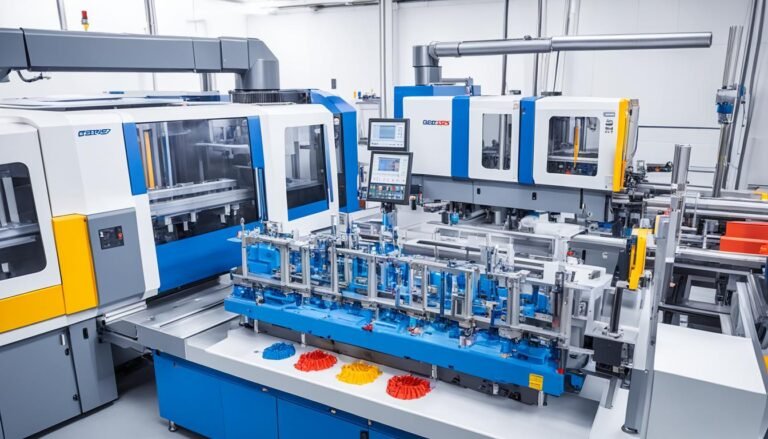How Material Properties Influence the Success of Injection Molding Optical Lenses
Ever thought about how the materials in injection molding affect optical lenses? The need for high-quality, yet affordable polymer optics is growing. This makes understanding material properties key for manufacturers. At THY Precision, we lead in blending materials science with precision optics manufacturing.
In the fast-changing world of THY Precision injection molding optical lenses, the choice of materials is crucial. It affects the lens’s performance, durability, and how well it focuses light. Materials like Poly(methyl methacrylate) (PMMA), cyclic olefin copolymer (COC), and cyclic olefin polymer (COP) each have benefits. These can make or break your injection molding optical lenses project.
Key Takeaways
- The selection of materials is crucial in injection molding optical lenses to ensure optimal performance, durability, and optical quality.
- Common polymers used in injection molding optical lenses include PMMA, PC, COC, and COP, each with their own unique properties and advantages.
- Understanding the influence of material properties on the success of injection molding optical lenses is essential for manufacturers to stay ahead in the rapidly evolving polymer optics industry.
- THY Precision is at the forefront of the injection molding optical lenses industry, leveraging material science expertise to deliver high-quality, cost-effective polymer optics solutions.
- Exploring the interplay between materials and the injection molding process can unlock new possibilities in the world of injection molding optical lenses.
Introduction to Injection Molding Optical Lenses
The rise of injection molding optical lenses has changed the game in optical manufacturing. This technology lets designers and engineers make a wide range of optical devices. These devices fit many different uses.
The Growing Demand for Polymer Optics
Optical polymers are becoming a top choice over traditional glass. They are strong, affordable, light, and can make complex shapes. This has made polymer optics more popular, letting designers try new ideas.
Advantages of Injection Molding Optical Lenses
Injection molding optical lenses have many benefits. They can make complex shapes like aspheric and freeform easily. They also combine mechanical and optical features, making them great for many uses. This includes everything from supermarket scanners to medical devices and gadgets for consumers.
Polymer optics are light and strong, offering a good alternative to glass. THY Precision uses this tech to make high-quality, affordable optical parts. These parts meet the changing needs of the industry.
“The versatility of polymer optics opens new doors for optical designers, enabling the successful development of many types of devices.”
Injection molding optical lenses are used in many fields. This includes telecommunications, LED lights, lidar, and time-of-flight tech. Their use shows how versatile and important this tech is. As we need more innovative optical solutions, injection molding optical lenses will play a big part in the future of making optics.
Key Material Properties for Optical Lenses
Choosing the right material is key for making top-notch optical lenses. THY Precision leads in making optical parts through injection molding. They know picking the best optical polymer materials is crucial. Properties like refractive index and Abbe number are vital for success in making lenses.
Common materials for injection molding include acrylic, styrene, polycarbonate, and others. Each has its own set of properties that designers must think about. Things like how the material changes shape with heat and its ability to handle high temperatures matter a lot.
| Material Property | Importance for Optical Injection Molding Lenses |
|---|---|
| Refractive Index | Determines the degree of light bending and is crucial for lens design. |
| Abbe Number | Measures the material’s dispersion, affecting chromatic aberration correction. |
| Birefringence | Can cause unwanted polarization effects and must be minimized. |
| Optical Transmission | Affects the light transmittance and overall optical performance. |
| Water Absorption | Impacts the dimensional stability and optical properties of the lens. |
| Thermal Expansion | Influences the lens shape and size, requiring careful mold design. |
THY Precision knows how important these material properties are for making lenses. By picking the right materials and fine-tuning the molding process, we can make sure your project succeeds.

“Choosing the right optical polymer materials is the foundation for creating high-performance injection molding optical lenses.”
Influence of Process Parameters
The success of injection molding optical lenses depends on how well material properties and the manufacturing process work together. The design of the mold and how the production is done are key to making high-quality polymer optics. Getting these right is crucial for making top-notch optical parts.
The Role of Mold Design
The mold in injection molding optical lenses is very important for the quality of the lenses. It must be designed well to copy the lens shape accurately. The inserts inside the mold, made of special metals, are turned to match the lens prescription for top accuracy. It’s also important to account for the plastic’s shrinkage when it cools to get the right size.
Optimizing the Production Process
To make injection molding optical lenses better, new technologies and methods are used. The variotherm system helps heat and cool the mold fast, which makes the lenses more accurate and reduces stress. Vacuum-assisted microinjection molding also helps make the lenses more precise. And using special cooling channels in the mold cuts down on stress caused by heat.
“The success of high-precision optical components fabricated through injection molding optical lenses hinges on the careful selection and optimization of the manufacturing process parameters.”
Knowing how mold design and process optimization affect injection molding optical lenses helps makers make parts that meet today’s tough standards. This knowledge and a drive for betterment are what make this method so powerful.
Challenges in Replicating Complex Geometries
Making injection molding optical lenses with detailed microstructures is hard. It needs a precise replication accuracy. This requires a well-set process window and careful adjustments.
Many have tried to solve this problem. They aim to improve the replication accuracy of polymer optics. By studying the injection molding optical lenses process, they found key factors. These include material properties, mold design, and process tweaks.
| Key Factors Influencing Replication Accuracy | Importance |
|---|---|
| Material Properties | Choosing the right polymer resins is key. They must have the right properties for accurate complex optical geometries. |
| Mold Design | The mold’s design is very important. It needs careful planning. This includes gate placement, cooling, and surface finish for replication accuracy. |
| Process Optimization | Optimizing the injection molding optical lenses process is crucial. This includes melt temperature, injection speed, and holding pressure for replication accuracy. |
By focusing on these areas, the injection molding optical lenses industry is making great strides. They’re unlocking new ways to make complex optical geometries. As demand for new polymer optics grows, improving replication accuracy is a top goal. This drives innovation in injection molding optical lenses technology.

injectionmoldingopticallenses: Enabling New Applications
Injection molding technology for optical lenses has opened up new doors in many industries. It’s now a key player in making high-quality, yet affordable, polymer optics. This process brings unmatched precision, efficiency, and the ability to make lots of items at once.
Emerging Trends and Future Outlook
There’s a big push in making better optical solutions for self-driving cars, electronics, solar panels, and medical tools. Thanks to injection molding, polymer optics are changing the game. They offer better performance, are more reliable, and save money.
New mold designs and better control over the process are big trends in injection molding optics. These changes mean lenses made this way are now good enough for very precise uses. Also, new materials science lets us make lenses that are better at handling heat, last longer, and have better optical quality.
The future looks bright for injection molding optical lenses. They can be made in large quantities at a lower cost, which is great for industries needing advanced optics. This tech is set to grow in fields like self-driving cars, solar energy, and medical tools, leading to more innovation.
Injection molding optical lenses are becoming a go-to for many uses, from everyday gadgets to advanced medical tools. As the field keeps evolving, the future of these lenses looks very promising. They could change many industries and how we see the world.
Conclusion
Injection molding of optical lenses is key to making complex polymer optics cheaply. THY Precision leads in this area, always innovating and making high-quality lenses.
The need for precise optical parts is growing fast. The success of making these parts depends on the materials, mold design, and how the process is done. THY Precision has tackled the tough task of making detailed shapes and reducing stress. They use the newest in materials, tools, and control techniques.
Looking to the future, injection molding of optical lenses will be crucial for new and creative uses. THY Precision is committed to leading in this field. They focus on quality and making customers happy, making them a reliable partner in creating new optical solutions.





